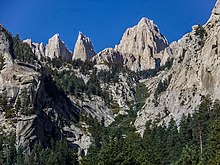John Muir Trail
The trail passes through large swaths of alpine and high mountain scenery, and lies almost entirely at or above 8,000 feet (2,400 m) in elevation.
[3][4][5][b] Prior to the arrival of European-American settlers, the Paiute people living in the High Sierra region utilized a series of ancestral trails for hunting and trade with neighboring indigenous groups.
"The idea of a crest-parallel trail came to me one day while herding my uncle's cattle in an immense unfenced alfalfa field near Fresno.
[12][13] Construction of the JMT began in 1915, a year after Muir's death, with a $10,000 appropriation from the California legislature and Governor Hiram Johnson.
[12][14] State Engineer Wilbur F. McClure was made responsible for overseeing the project and selecting the final route, though he secured the cooperation of the United States Forest Service, which managed and supervised much of the actual construction, and LeConte was very influential regarding the eventual routing of the trail.
[17] William Edward Colby, the first secretary of the Sierra Club, called the finished trail "a most appropriate memorial to John Muir, who spent many of the best years of his life exploring the region which it will make accessible.
[2] From its northern terminus in Yosemite Valley, the trail runs southeast, passing south of Half Dome and then on to Tuolumne Meadows.
Although broad and well-traveled, hazardous winter conditions and close proximity to civilization (attracting large numbers of day hikers) make this one of the most dangerous parts of the trail.
The John Muir Trail/Pacific Crest Trail then turns south, through the mild Lyell Canyon meadow, and crosses the Cathedral Range again and exits the park at Donahue Pass.
[3] At the crest of Donahue Pass, the trail enters Inyo National Forest and the Ansel Adams Wilderness.
[29] When the United States Geological Survey calculated the official length of the trail, elevation gain and loss was not taken into consideration.
Rather, the triangle inequality implies that the error due to neglecting elevation changes underestimates the true length by no greater than this value.
[12][1] Early season hikers have to contend not only with the snowpack and icy slopes near the passes, but with streams swollen with snowmelt.
Trail conditions are less demanding later in the season after the snowmelt concludes, and the weather generally remains pleasant for hiking through September.
[33] The record for the fastest known time was set by ultrarunner François D'Haene in 2017, who ran from south to north in 2 days, 19 hours and 26 minutes.
[34] The record for the fastest trip in an unsupported way was set by Aurélien Sanchez in 2018, who ran from south to north in 3 days, 3 hours and 55 minutes.
The Whitney Portal end of the JMT has a lottery for wilderness permits, and hikers starting in Yosemite face competition with other backpackers simply wanting to camp overnight while hiking Half Dome or to Tuolumne Meadows.
In addition, there are several resupply points convenient to the JMT during its northern half (Tuolumne Meadows, Reds Meadow, Vermillion Valley Resort, Muir Trail Ranch), allowing the hiker to carry a lighter food load early in the hike and also to exit the trail easily if problems arise.








